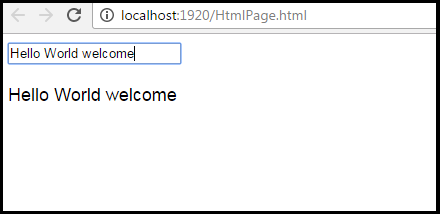In this article, I will show you two way data binding angularjs tutorial with examples. The model and view will be synchronized at all time. It means a change in the model will automatically keep on changing view updates the model automatically.
script.js
///<reference path="Script/angular.min.js" />
var myapp = angular.module("Module1", [])
.controller("mycontroller",function($scope) {
$scope.message= "Hello World";
});
View:
<script type="text/javascript" src="https://ajax.googleapis.com/ajax/libs/angularjs/1.5.8/angular.js"></script>
<script src="Script.js" type="text/javascript"></script>
<body ng-app="Module1">
<div ng-controller="mycontroller">
<div>
<input type="text" ng-model="message" /> </br></br>
{{ message }}
</div>
</div>
</body>
Description:
As here, I added a simple message property to the scope object and use this message property within binding expression [{{ message }}] in our view to display hello world. By the help of the binding expression, it updates the view when the model changes and the Data binding are achieved by the ng-model directive. The ng-model helps to update the model when the view changes.
Output:
Post your comments / questions
Recent Article
- How to create custom 404 error page in Django?
- Requested setting INSTALLED_APPS, but settings are not configured. You must either define..
- ValueError:All arrays must be of the same length - Python
- Check hostname requires server hostname - SOLVED
- How to restrict access to the page Access only for logged user in Django
- Migration admin.0001_initial is applied before its dependency admin.0001_initial on database default
- Add or change a related_name argument to the definition for 'auth.User.groups' or 'DriverUser.groups'. -Django ERROR
- Addition of two numbers in django python

Related Article